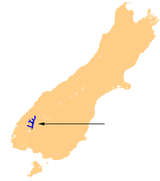Lake Te Anau
| Lake Te Anau | |
|---|---|
 | |
| Location | Southland District, Southland Region, South Island |
| Coordinates | 45°12′S 167°48′E / 45.200°S 167.800°ECoordinates: 45°12′S 167°48′E / 45.200°S 167.800°E |
| Primary inflows | Eglinton River, Clinton River, Worsley River, Glaisnock River, Wapiti River, Doon River, Mckenzie Burn, Upukeroa River |
| Primary outflows | Waiau River |
| Basin countries | New Zealand |
| Max. length | 65 km |
| Surface area | 344 km² |
| Max. depth | 417 m |
| Surface elevation | 210 m |
| Settlements | Te Anau |

Lake Te Anau is in the southwestern corner of the South Island of New Zealand. Its name was originally Te Ana-au, Maori for 'The cave of swirling water'. The lake covers an area of 344 km², making it the second-largest lake by surface area in New Zealand (after Lake Taupo) and the largest in the South Island. Lake Te Anau is however the largest lake in Australasia by fresh water volume.[1]
The main body of the lake runs north-south, and is 65 km in length. Three large fiords form arms to the lake on its western flank: North Fiord, Middle Fiord and South Fiord. These are the only inland Fiords that New Zealand has, the other 14 are out on the coast. Several small islands lie in the entrance to Middle Fiord, which forks partway along its length into northwest and southwest arms. The lake lies at an altitude of 210 m, and since its maximum depth is 417 m[2] much of its bed lies below sea level.
Several rivers feed the lake, of which the most important is the Eglinton River, which joins the lake from the east, opposite the entrance to North Fiord. The outflow is the Waiau River, which flows south for several kilometres into Lake Manapouri. The town of Te Anau lies at the south-eastern corner of the lake, close to the outflow.
Most of the lake is within Fiordland National Park and the Te Wahipounamu World Heritage site. Other than the Te Anau township, the only human habitation close to the lake is the farming settlement of Te Anau Downs, close to the mouth of the Eglinton River. Between these two settlements the land is rolling hill country, but elsewhere the land is mountainous, especially along its western shore, where the Kepler and Murchison Mountains rise 1,400 m above the surface of the lake.

Two New Zealand Great Walks start at the lake. The Milford Track starts at the northern tip of the lake and the Kepler Track starts and ends at the south tip of the lake at the Waiau River.
Flora and fauna
Numerous species of wildlife and vegetation are found in the watershed of Lake Te Anau. Vegetative understory includes numerous fern species including the Crown Fern, Blechnum discolor.[3]
Several species of endangered birds live around the shores of Lake Te Anau, notably the Takahē (Notornis hochstetteri). An area between the Middle and South Fiords called the Murchison Mountains is a sanctuary set aside for these birds. The western shore of the lake also features the Te Ana-au Caves.
See also
- List of lakes in New Zealand
Notes
References
| Wikimedia Commons has media related to Lake Te Anau. |
- New Zealand Department of Conservation (2004). Fiordland (Map). 1 : 255,000. Parkmap. Cartography by GeoSmart (NZ) Ltd (5th ed.).
- C. Michael Hogan. 2009. Crown Fern: Blechnum discolor, Globaltwitcher.com, ed. N. Stromberg
| ||||||||||||||||||||||||||